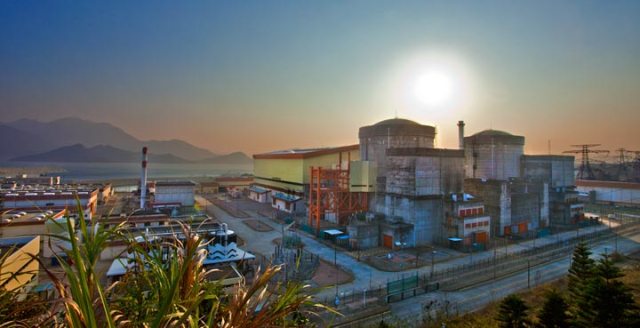Feb 15 2016
Members of the International Daya Bay Collaboration, who track the production and flavor-shifting behavior of electron antineutrinos generated at a nuclear power complex in China, have obtained the most precise measurement of these subatomic particles' energy spectrum ever recorded.
 The Daya Bay experiment measures the antineutrinos produced by the reactors of the Daya Bay Nuclear Power Plant and the Ling Ao Nuclear Power Plant in mainland China. The photo shows a panoramic view of the Daya Bay reactor complex. (Photo by Roy Kaltschmidt, Berkeley Lab)
The Daya Bay experiment measures the antineutrinos produced by the reactors of the Daya Bay Nuclear Power Plant and the Ling Ao Nuclear Power Plant in mainland China. The photo shows a panoramic view of the Daya Bay reactor complex. (Photo by Roy Kaltschmidt, Berkeley Lab)
The data generated from the world's largest sample of reactor antineutrinos indicate two intriguing discrepancies with theoretical predictions and provide an important measurement that will shape future reactor neutrino experiments. The results have been published in the journal Physical Review Letters.
Studying the behavior of elusive neutrinos holds the potential to unlock many secrets of physics, including details about the history, makeup, and fate of our universe. Neutrinos were among the most abundant particles at the time of the Big Bang, and are still generated abundantly today in the nuclear reactions that power stars and in collisions of cosmic rays with Earth's atmosphere.
Brookhaven scientists also led the core analysis group that contributed to the measurements of reactor antineutrino energy spectrum and flux. Read more.
They are also emitted as a by-product of power generation in man-made nuclear reactors, giving scientists a powerful way to study them on Earth in a controlled manner. In fact, the study of particles emitted by reactors led to the first detection of neutrinos in the 1950s, a finding once considered impossible due to the extreme inert nature of these particles, which were then only predicted. Since that time reactor experiments, including Daya Bay, have played a crucial role in uncovering the secrets of neutrino oscillation—their tendency to switch among three known flavors: electron, muon, and tau—and other important neutrino properties.
A crucial factor for many of these experiments is knowing how many antineutrinos are emitted in total in these nuclear reactions (the flux), and how many are being produced at particular energies (the energy distribution, or spectrum). In early studies, scientists relied on calculations or other indirect means, such as electron spectrum measurements made on reactor fuels, to estimate these numbers, based on their understanding of the complex fission processes in the reactor core. These methods have rather strong dependence on theoretical models.
The Daya Bay Collaboration now provides the most precise model-independent measurement of the energy spectrum of these elusive particles, and a new measurement of total antineutrino flux. The data were gathered by analyzing more than 300,000 reactor antineutrinos collected over the course of 217 days. The most challenging part of this work was to accurately calibrate the energy response of the detectors. Through dedicated calibration and analysis effort, Daya Bay was able to measure the neutrino energy to an unprecedented precision, better than 1 percent, over a broad energy range of the reactor antineutrinos.
The measured reactor antineutrino spectrum shows a surprising feature: an excess of antineutrinos at an energy of around 5 million electron volts (MeV) compared with theoretical expectations. This represents a deviation of about 10 percent between the experimental measurement and calculations based on the theoretical models—well beyond the uncertainties—leading to a discrepancy of up to four standard deviations. "This unexpected disagreement between our observation and predictions strongly suggested that the current calculations would need some refinement," commented Kam-Biu Luk of the University of California at Berkeley and DOE's Lawrence Berkeley National Laboratory, a co-spokesperson of the Daya Bay Collaboration. Two other experiments have shown a similar excess at this energy, though with less precision than the new Daya Bay result.
Such deviation shows the importance of the direct measurement of the reactor antineutrino spectrum, particularly for experiments that use the spectrum to measure neutrino oscillations, and may indicate the need to revisit the models underlying the calculations. "We expect that the spectrum measured by Daya Bay will improve with more data and better understanding of the detector response. These improved measurements will be essential for next-generation reactor neutrino experiments such as JUNO," said Jun Cao of the Institute of High Energy Physics (IHEP) in China, a co-spokesperson of Daya Bay and the deputy spokesperson of JUNO, an experiment being built 200 kilometers away from Daya Bay.
Daya Bay's measurement of antineutrino flux—the total number of antineutrinos emitted across the entire energy range—indicates that the reactors are producing 6 percent fewer antineutrinos overall when compared to some of the model-based predictions. This result is consistent with past measurements. This observed deficit has been named the "Reactor Antineutrino Anomaly." This disagreement could arise from the imperfection of the models. Or, more intriguingly, it could be the result of an oscillation involving a new kind of neutrino, the so-called sterile neutrino—postulated by some theories but yet to be detected. Whether the anomaly exists is still an open question.
Background on Daya Bay
The Daya Bay nuclear power complex is located on the southern coast of China, 55 kilometers northeast of Hong Kong. It consists of three nuclear power plants, each with two reactor cores. All six cores are pressurized water reactors with similar design, and each can generate up to 2.9 gigawatt thermal power. Every second, the six reactors emit 3,500 billion billon electron antineutrinos. For this measurement, the Daya Bay experiment used six detectors located at 360 meters to 1.9 kilometers from the reactors. Each detector contains 20 tons of gadolinium-doped liquid scintillator to catch the reactor antineutrinos.